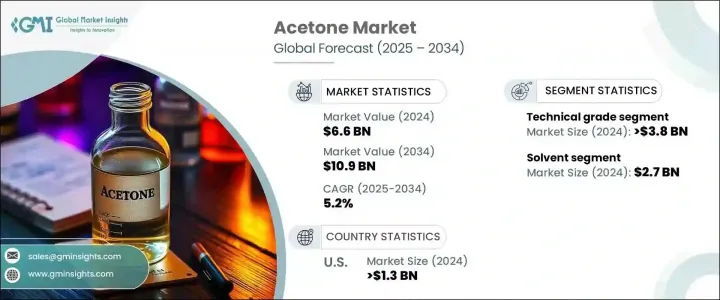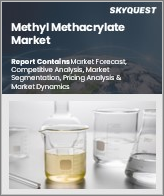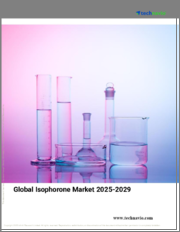
|
시장보고서
상품코드
1684692
아세톤 시장 기회, 성장 촉진 요인, 산업 동향 분석, 예측(2025-2034년)Acetone Market Opportunity, Growth Drivers, Industry Trend Analysis, and Forecast 2025 - 2034 |
||||||
아세톤 세계 시장은 2024년에 66억 달러로 평가되었고, 2025년부터 2034년에 걸쳐 CAGR 5.2%로 확대될 것으로 예측되고 있습니다.
화학, 의약품, 자동차, 화장품 등 여러 산업에서의 아세톤 수요 증가가 일관된 성장의 원동력이 되고 있습니다. 다용도 용매인 아세톤은 도료, 코팅제, 접착제의 제조에 중요한 역할을 하며, 산업용도에 필수적인 성분이 되고 있습니다. 특히 신흥국에서는 산업화의 페이스가 가속되고 있어 플라스틱, 합성섬유, 특수화학제품의 제조에 있어서의 아세톤 소비 증가에 박차를 가하고 있습니다. 제약 분야는 의약품 제형, 추출 공정 및 멸균 용도에 널리 사용되기 때문에 아세톤의 주요 소비자입니다.

화장품 업계도 아세톤 시장에 크게 공헌하고 있으며, 미용 및 퍼스널케어 제품에 그 용제 특성을 활용하고 있습니다. 산업 및 상업 용도 외에도 실험 및 연구 용도에서 아세톤의 역할도 점점 더 중요해지고 있습니다. 기술의 진보와 지속가능한 대안의 추진은 효율을 유지하면서 환경에 미치는 영향을 줄이는 바이오 아세톤에 기회를 낳고 있습니다. 시장 관계자는 또한 순도 수준 향상, 지속가능성 개선 및 성능 최적화를 위해 혁신적인 생산 기술에 투자하고 있습니다.
| 시장 범위 | |
|---|---|
| 시작 연도 | 2024년 |
| 예측연도 | 2025-2034년 |
| 시작 금액 | 66억 달러 |
| 예측 금액 | 109억 달러 |
| CAGR | 5.2% |
기술 등급 부문은 2024년 38억 달러를 차지했으며 2034년까지 연평균 복합 성장률(CAGR) 5.3%로 성장할 것으로 예측됩니다. 이 분야는 초고순도를 필요로 하지 않는 산업용으로 널리 사용되고 있기 때문에 우위를 차지하고 있습니다. 자동차 산업, 건설 산업 및 화학 산업에서는 용매 기반 응용 분야에서 비용 효율성과 효율성이 높기 때문에 기술 등급의 아세톤이 선호됩니다. 접착제, 코팅제, 세정제의 제조에 있어서, 탈지제, 희석제로서 기능하는 중요한 성분입니다. 기술 급료 아세톤의 합리적인 가격과 다용도는 다양한 분야에서 지속적인 수요를 확보하고 시장 내 중요한 부문으로 자리매김하고 있습니다.
솔벤트 분야는 2024년 27억 달러로 평가되었고, 2034년까지 연평균 복합 성장률(CAGR) 5.4%로 성장할 것으로 예상됩니다. 솔벤트는 다양한 산업에서 필수적인 역할을 하므로 아세톤 시장에서 가장 큰 점유율을 차지합니다. 페인트 및 코팅은 여전히 중요한 용도이며, 아세톤은 수지를 효율적으로 용해시켜 제품의 성능을 향상시키고 있습니다. 자동차 산업은 계속해서 수요를 견인하고 있어, 재도장이나 수리 공정에 있어서의 탈지나 표면 처리에 아세톤을 활용하고 있습니다. 제약 및 화장품 분야에서는 의약품의 제제, 추출, 매니큐어의 제광액과 같은 퍼스널케어 제품에 아세톤이 많이 사용되고 있습니다. 광범위한 물질을 용해시키는 능력을 지닌 아세톤은 많은 산업용 및 소비자용 응용 분야의 기본 성분으로 지속적으로 장기적인 시장 성장을 보장합니다.
미국의 아세톤 시장은 2024년에 13억 달러를 차지하고 2034년까지 연평균 복합 성장률(CAGR) 4%로 성장할 것으로 보입니다. 아세톤의 주요 생산국과 소비국 중 하나인 미국은 강력한 산업 인프라와 첨단 제조 능력의 혜택을 누리고 있습니다. 자동차, 의약품, 화장품 부문 수요는 계속 높아 시장 확대를 견인하고 있습니다. 미국의 화학 산업은 특히 페인트, 코팅제, 접착제 등의 용제 응용 분야에서 아세톤 소비량을 증가시키는 데 중요한 역할을 합니다. 또한 바이오 아세톤 생산이 진행됨에 따라 미국은 지속 가능한 솔루션의 리더로 자리매김하고 있습니다.
목차
제1장 조사 방법과 조사 범위
- 시장 범위와 정의
- 기본 추정과 계산
- 예측 계산
- 데이터 소스
- 1차 데이터
- 2차 데이터
- 유료 정보원
- 공적 정보원
제2장 주요 요약
제3장 업계 인사이트
- 생태계 분석
- 밸류체인에 영향을 주는 요인
- 이익률 분석
- 파괴
- 장래의 전망
- 제조업체
- 유통업체
- 공급자의 상황
- 이익률 분석
- 주요 뉴스
- 규제 상황
- 영향요인
- 성장 촉진요인
- 페인트 및 코팅 수요 증가
- 의약품 부문 확대
- 자동차 산업 활동의 활성화
- 업계의 잠재적 위험 및 과제
- 원료 가격의 변동
- 성장 촉진요인
- 성장 가능성 분석
- Porter's Five Forces 분석
- PESTEL 분석
제4장 경쟁 구도
- 소개
- 기업 점유율 분석
- 경쟁 포지셔닝 매트릭스
- 전략 전망 매트릭스
제5장 시장 추정 및 예측 : 그레이드별, 2021년-2034년
- 주요 동향
- 테크니컬 그레이드
- 공업용 등급
- 의약품 등급
제6장 시장 추정 및 예측 : 용도별, 2021년-2034년
- 주요 동향
- 용제
- 페인트
- 접착제
- 세정제
- 화학 중간체
- 메틸메타크릴레이트(MMA)
- 비스페놀 A(BPA)
- 의약품
- 의약품 제제
- 의료기기 세척
- 퍼스널케어 및 화장품
- 네일 폴란드어 리무버
- 스킨케어 제품
- 기타
제7장 시장 추정 및 예측 : 지역별, 2021년-2034년
- 주요 동향
- 북미
- 미국
- 캐나다
- 유럽
- 영국
- 독일
- 프랑스
- 이탈리아
- 스페인
- 러시아
- 아시아태평양
- 중국
- 인도
- 일본
- 한국
- 호주
- 라틴아메리카
- 브라질
- 멕시코
- 중동 및 아프리카
- 남아프리카
- 사우디아라비아
- 아랍에미리트(UAE)
제8장 기업 프로파일
- ALTIVIA
- Arkema
- Cepsa Quimica
- Honeywell International
- INEOS
- LyondellBasell Industries
- Mitsui Chemicals
- SABIC
- Shell plc
- Solvay
- The Dow Chemical Company
The Global Acetone Market reached a valuation of USD 6.6 billion in 2024 and is projected to expand at a CAGR of 5.2% between 2025 and 2034. The rising demand for acetone across multiple industries, including chemicals, pharmaceuticals, automotive, and cosmetics, is driving consistent growth. As a versatile solvent, acetone plays a critical role in the production of paints, coatings, and adhesives, making it an essential component in industrial applications. The accelerating pace of industrialization, especially in emerging economies, is fueling higher consumption of acetone in the manufacturing of plastics, synthetic fibers, and specialty chemicals. The pharmaceutical sector continues to be a major consumer of acetone due to its widespread use in drug formulation, extraction processes, and sterilization applications.

The cosmetics industry also contributes significantly to the acetone market, leveraging its solvent properties in beauty and personal care products. In addition to its industrial and commercial applications, acetone's role in laboratory and research-based settings is becoming increasingly important. Advances in technology and the push for sustainable alternatives are creating opportunities for bio-based acetone, reducing environmental impact while maintaining efficiency. Market players are also investing in innovative production techniques to enhance purity levels, improve sustainability, and optimize performance.
| Market Scope | |
|---|---|
| Start Year | 2024 |
| Forecast Year | 2025-2034 |
| Start Value | $6.6 Billion |
| Forecast Value | $10.9 Billion |
| CAGR | 5.2% |
The technical grade segment accounted for USD 3.8 billion in 2024 and is anticipated to grow at a 5.3% CAGR through 2034. This category dominates due to its extensive use in industrial applications where ultra-high purity is not necessary. Automotive, construction, and chemical industries favor technical grade acetone for its cost-effectiveness and efficiency in solvent-based applications. It serves as a key ingredient in manufacturing adhesives, coatings, and cleaning agents, functioning as a degreasing and thinning agent. The affordability and versatility of technical grade acetone ensure its continued demand across multiple sectors, positioning it as a crucial segment within the market.
The solvent segment generated USD 2.7 billion in 2024 and is expected to grow at a CAGR of 5.4% through 2034. Solvents represent the largest share of the acetone market due to their indispensable role across various industries. Paints and coatings remain a key application, where acetone enhances product performance by dissolving resins efficiently. The automotive industry continues to drive demand, utilizing acetone for degreasing and surface preparation in refinishing and repair processes. Pharmaceutical and cosmetic sectors rely heavily on acetone for drug formulations, extractions, and personal care products such as nail polish removers. With its ability to dissolve a wide range of substances, acetone remains a fundamental component in numerous industrial and consumer applications, ensuring long-term market growth.
The US acetone market accounted for USD 1.3 billion in 2024 and is set to grow at a CAGR of 4% through 2034. As one of the leading producers and consumers of acetone, the United States benefits from a strong industrial infrastructure and advanced manufacturing capabilities. Demand remains high across the automotive, pharmaceutical, and cosmetics sectors, driving market expansion. The US chemical industry plays a crucial role in increasing acetone consumption, particularly in solvent applications such as paints, coatings, and adhesives. Additionally, ongoing advancements in bio-based acetone production are positioning the country as a leader in sustainable solutions.
Table of Contents
Chapter 1 Methodology & Scope
- 1.1 Market scope & definitions
- 1.2 Base estimates & calculations
- 1.3 Forecast calculations
- 1.4 Data sources
- 1.4.1 Primary
- 1.4.2 Secondary
- 1.4.2.1 Paid sources
- 1.4.2.2 Public sources
Chapter 2 Executive Summary
- 2.1 Industry synopsis, 2021-2034
Chapter 3 Industry Insights
- 3.1 Industry ecosystem analysis
- 3.1.1 Factor affecting the value chain
- 3.1.2 Profit margin analysis
- 3.1.3 Disruptions
- 3.1.4 Future outlook
- 3.1.5 Manufacturers
- 3.1.6 Distributors
- 3.2 Supplier landscape
- 3.3 Profit margin analysis
- 3.4 Key news & initiatives
- 3.5 Regulatory landscape
- 3.6 Impact forces
- 3.6.1 Growth drivers
- 3.6.1.1 Increasing demand in paints and coatings
- 3.6.1.2 Expansion of the pharmaceutical sector
- 3.6.1.3 Rising automotive industry activities
- 3.6.2 Industry pitfalls & challenges
- 3.6.2.1 Volatility in raw material prices
- 3.6.1 Growth drivers
- 3.7 Growth potential analysis
- 3.8 Porter's analysis
- 3.9 PESTEL analysis
Chapter 4 Competitive Landscape, 2024
- 4.1 Introduction
- 4.2 Company market share analysis
- 4.3 Competitive positioning matrix
- 4.4 Strategic outlook matrix
Chapter 5 Market Estimates & Forecast, By Grade, 2021-2034 (USD Billion) (Kilo Tons)
- 5.1 Key trends
- 5.2 Technical grade
- 5.3 Industrial grade
- 5.4 Pharmaceutical grade
Chapter 6 Market Estimates & Forecast, By Application, 2021-2034 (USD Billion) (Kilo Tons)
- 6.1 Key trends
- 6.2 Solvent
- 6.2.1 Paints and coatings
- 6.2.2 Adhesives
- 6.2.3 Cleaning agents
- 6.3 Chemical intermediate
- 6.3.1 Methyl methacrylate (MMA)
- 6.3.2 Bisphenol A (BPA)
- 6.4 Pharmaceuticals
- 6.4.1 Drug formulations
- 6.4.2 Medical equipment cleaning
- 6.5 Personal care and cosmetics
- 6.5.1 Nail polish removers
- 6.5.2 Skin care products
- 6.6 Others
Chapter 7 Market Estimates & Forecast, By Region, 2021-2034 (USD Billion) (Kilo Tons)
- 7.1 Key trends
- 7.2 North America
- 7.2.1 U.S.
- 7.2.2 Canada
- 7.3 Europe
- 7.3.1 UK
- 7.3.2 Germany
- 7.3.3 France
- 7.3.4 Italy
- 7.3.5 Spain
- 7.3.6 Russia
- 7.4 Asia Pacific
- 7.4.1 China
- 7.4.2 India
- 7.4.3 Japan
- 7.4.4 South Korea
- 7.4.5 Australia
- 7.5 Latin America
- 7.5.1 Brazil
- 7.5.2 Mexico
- 7.6 MEA
- 7.6.1 South Africa
- 7.6.2 Saudi Arabia
- 7.6.3 UAE
Chapter 8 Company Profiles
- 8.1 ALTIVIA
- 8.2 Arkema
- 8.3 Cepsa Quimica
- 8.4 Honeywell International
- 8.5 INEOS
- 8.6 LyondellBasell Industries
- 8.7 Mitsui Chemicals
- 8.8 SABIC
- 8.9 Shell plc
- 8.10 Solvay
- 8.11 The Dow Chemical Company



















